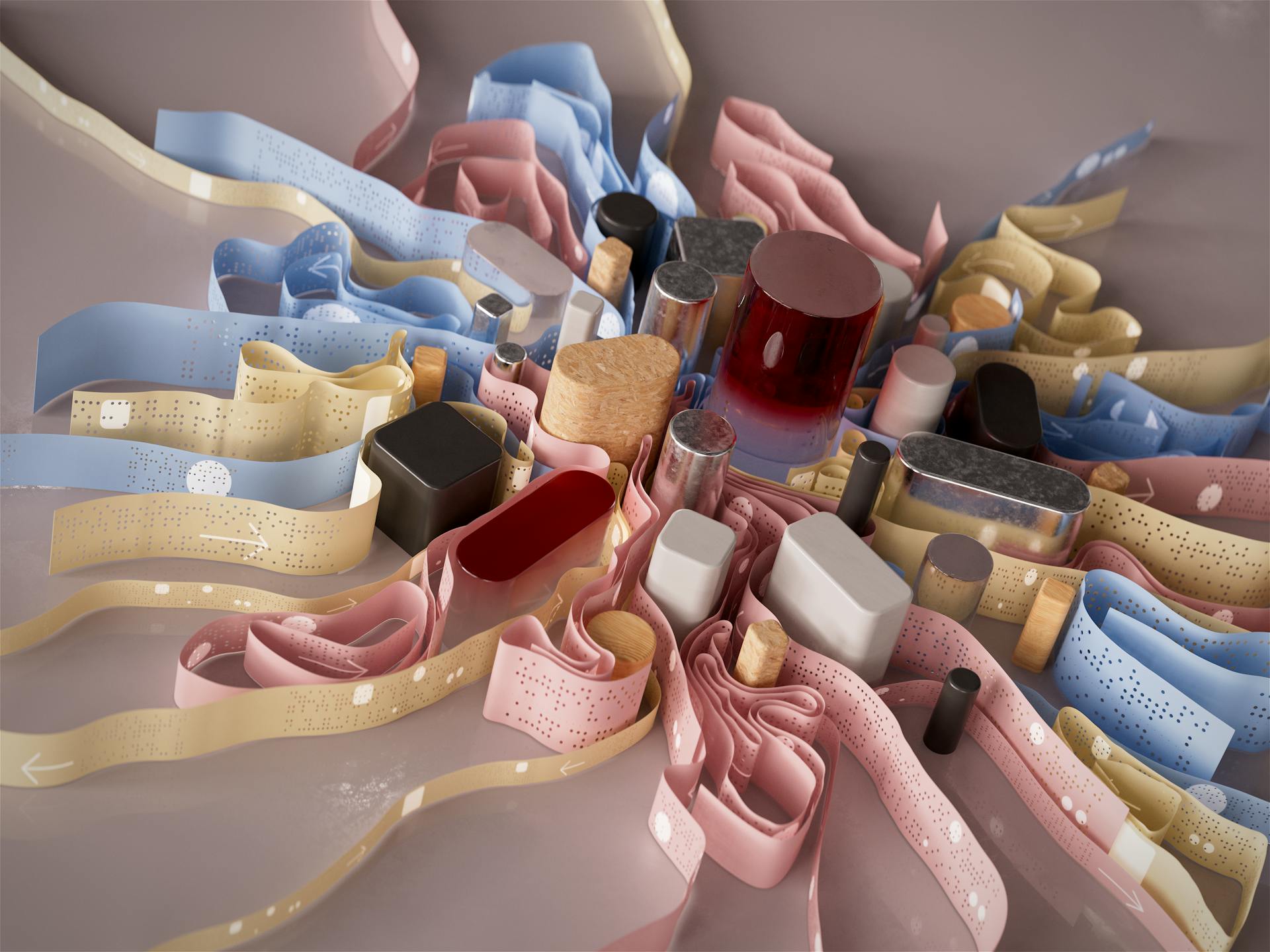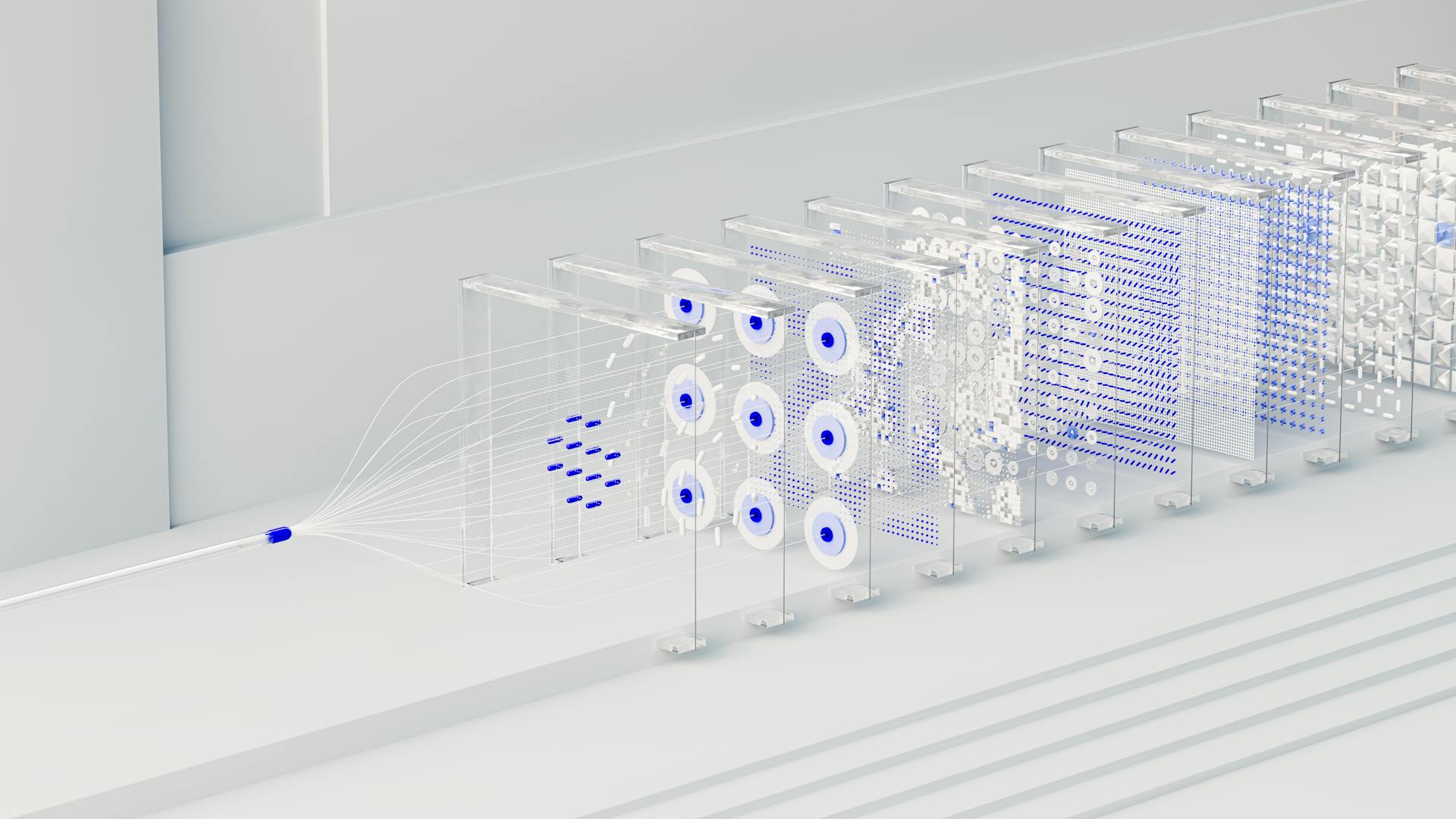
Fine-tuning a deep learning model from scratch to success is a meticulous process that requires patience and persistence. The first step is to choose a pre-trained model that aligns with your project's requirements.
A good starting point is to select a model that has been trained on a large dataset, such as ImageNet, which contains over 14 million images. This can save you a significant amount of time and computational resources.
The pre-trained model's weights need to be loaded into your project, and then you can fine-tune the model by adjusting the weights and optimizing the hyperparameters.
Discover more: Pre Trained vs Fine Tune
What Is Fine-Tuning?
Fine-tuning is a type of transfer learning that can outperform feature extraction.
It involves taking a pre-trained CNN, cutting off the final set of fully connected layers, and replacing them with new ones.
We then freeze all layers below the head, so their weights cannot be updated, and train the network with a small learning rate.
This allows the new set of fully connected layers to learn patterns from the previously learned CONV layers.
By doing so, we can utilize pre-trained networks to recognize classes they were not originally trained on.
This method can lead to higher accuracy than transfer learning via feature extraction.
Suggestion: Hidden Layers
Why Fine-Tune?
Fine-tuning is a game-changer in the world of deep learning. It allows us to take advantage of a pre-trained model's knowledge without having to start from scratch.
Assuming the original task is similar to the new task, we can utilize a pre-trained model to expedite the learning process. This approach is attractive because it saves us from the trial-and-error process of building a model from the ground up.
Building a model from scratch can be a daunting task, with many variables to consider, such as the number of layers, types of layers, order of layers, number of nodes in each layer, regularization, and learning rate.
The fine-tuning approach is particularly useful when working with limited datasets, as it typically requires less data to fine-tune a pre-trained model than to train a model from scratch.
Here are some of the key advantages of fine-tuning:
- Efficiency in Training: Utilizing pre-trained models can expedite the training process, as they have already grasped foundational features from extensive datasets.
- Data Economy: Since the model has undergone training on vast datasets, fine-tuning typically demands a smaller amount of data, making it ideal for tasks with limited datasets.
By leveraging a pre-trained model, we can tap into its knowledge of foundational features, such as edges, shapes, textures, and more, which can be applied to our specific task.
Preparation
To prepare your data for fine-tuning, you need to clean and preprocess it to make it suitable for training. This involves splitting your data into training and validation sets to evaluate the performance of your model.
The format of your data should match the format expected by the pre-trained model you are using, which can be found in the model card's Instruction format section on HuggingFace. Most model cards will include a template for building a prompt for the model and some pseudo-code to help you get started.
Related reading: Hugging Face Transformers Format
Select a Pre-Trained Model
Selecting a pre-trained model is a crucial step in the fine-tuning process. You should choose a model that has been trained on a similar task to the one you are working on, as this will help you leverage the knowledge that the model has already learned and adjust it to better fit your data.
HuggingFace models are a great place to start your search for a pre-trained model. They are grouped into categories based on the task they were trained on, making it easy to find a model that suits your needs.
The categories include multimodal, computer vision, natural language processing, audio, tabular, and reinforcement learning. You can check the status and license of the model, as some may be available under an open-source license, while others may require a commercial or personal license to use.
All the models on HuggingFace include license information, so make sure you have the necessary permissions to use the model before fine-tuning it.
Here are some of the categories of pre-trained models available on HuggingFace:
- Multimodal
- Computer vision
- Natural language processing
- Audio
- Tabular
- Reinforcement learning
By selecting a pre-trained model that fits your task requirements, you can save time and effort in the fine-tuning process and improve the performance of your model.
Prepare Sample Data
To prepare your sample data, you should clean and preprocess it to make it suitable for training. This process ensures your data is in the right format for the pre-trained model you're using.
You'll need to split your data into training and validation sets to evaluate the performance of your model. This is a crucial step in the preparation process.
The format of your data should match the format expected by the pre-trained model. You can find this information in the model card's Instruction format section on HuggingFace.
Most model cards will include a template for building a prompt for the model and some pseudo-code to help you get started.
Initialization of Weights
Random initialization is a common method used to assign weights to neural networks, ensuring a break in symmetry among neurons and preventing them from updating similarly during backpropagation.
This method can sometimes lead to slow convergence or the vanishing gradient problem, which is why specific strategies like He or Xavier initialization have been proposed.
He initialization, designed for ReLU activation functions, initializes weights based on the size of the previous layer, ensuring that the variance remains consistent across layers.
This approach can lead to faster and more stable convergence, making it a popular choice among deep learning practitioners.
Xavier initialization, on the other hand, considers the sizes of the current and previous layers, making it suitable for tanh activation functions.
By using these methods, you can avoid the pitfalls of random initialization and get your neural networks up and running efficiently.
Expand your knowledge: Conditional Random Fields
The Process
Fine-tuning is a process that allows you to take advantage of pre-trained neural networks by adapting them to your specific task. This can save a significant amount of time and computational resources.
To fine-tune a neural network, you need to start with a pre-trained model. In the case of deep learning, this often means taking a pre-trained neural network and modifying it to fit your specific task.
The process of fine-tuning involves making adjustments to the model's parameters, such as the weights and biases, to better suit your task. This can involve adding or removing layers, adjusting the learning rate, or changing the optimizer.
Fine-tuning can be done on a small subset of the original dataset, which can help you get started quickly.
Here's an interesting read: Hidden Layers in Neural Networks Code Examples Tensorflow
Training and Updates
Backpropagation plays a crucial role in deep learning, as it computes the gradient of the loss function concerning each weight by applying the chain rule.
The learning rate is a hyperparameter that dictates the step size during weight updates, making it a critical component in the training process.
Batch Gradient Descent is the most basic form of gradient descent algorithm, but it can be slow and inefficient for large datasets.
Stochastic Gradient Descent (SGD) and Mini-Batch Gradient Descent have been introduced to improve efficiency and convergence, making them more suitable for large-scale deep learning tasks.
A high learning rate might overshoot the optimal point, while a low learning rate might result in slow convergence, making it essential to find the right balance.
Adaptive learning rate methods like Adam, RMSprop, and Adagrad adjust the learning rate during training, facilitating faster convergence without manual tuning.
You might like: Proximal Gradient Methods for Learning
Strategies and Techniques
Regularization techniques like dropout and L1/L2 regularization are essential for preventing overfitting in deep learning models. Dropout randomly deactivates neurons during training to prevent overreliance on specific neurons.
L1 and L2 regularization add penalties to the loss function to prevent weights from becoming too large and promote feature selection. L1 adds a penalty equivalent to the absolute value of the weights' magnitude, while L2 adds a penalty based on the squared magnitude of weights.
Adjusting learning rates is a key strategy in fine-tuning, with lower rates often preferred for stability and retaining previously learned features. Freezing initial layers during fine-tuning can also be beneficial, as they capture more generic features.
Explore further: Learning Rates
Regularization Techniques
Regularization Techniques are a must-have in deep learning to prevent overfitting. Overfitting occurs when a model performs exceptionally well on the training data but struggles with unseen data.
Dropout is a popular regularization technique that randomly deactivates neurons during training, ensuring the model doesn't rely on specific neurons. This helps prevent the model from becoming too complex and overfitting the training data.
L1 and L2 regularization are two other techniques that add a penalty to the loss function, preventing weights from becoming too large. L1 regularization aids feature selection by adding a penalty equivalent to the absolute value of the weights' magnitude.
L2 regularization adds a penalty based on the squared magnitude of weights, which helps prevent weights from reaching extremely high values and produces a more generalized model.
Expand your knowledge: Applied Machine Learning Explainability Techniques
Strategies for
Adjusting learning rates is a key strategy in fine-tuning, as it makes the process more stable and helps the model retain previously learned features.
A lower learning rate is often preferred because it prevents drastic alterations to the model during fine-tuning.
Freezing the initial layers of the model during fine-tuning is another effective strategy, as it ensures the model's previously learned features are retained.
By freezing the initial layers, you're allowing the model to focus on adapting to the new task or dataset without altering the generic features it's already learned.
Low-rank adaptation (LoRA) is an adapter-based technique for efficiently fine-tuning models, allowing for performance that approaches full-model fine-tuning with less space requirement.
This technique involves designing a low-rank matrix that's added to the original matrix, producing a fine-tuned model with significantly fewer parameters.
For your interest: Fine-tuning vs Transfer Learning
Representation
Representation is a crucial aspect of fine-tuning large language models (LLMs). Representation fine-tuning, or ReFT, is a novel technique developed by researchers at Stanford University.
This approach focuses on modifying less than 1% of an LLM's representations, rather than updating weights. Unlike traditional parameter-efficient fine-tuning methods, ReFT targets specific parts of the model relevant to the task being fine-tuned.
Take a look at this: Fine-tuning Huggingface Model with Custom Dataset
ReFT methods operate on a frozen base model, learning task-specific interventions on hidden representations. These interventions manipulate a small fraction of model representations to steer model behaviors towards solving downstream tasks at inference time.
LoReFT, a specific method within the ReFT family, intervenes on hidden representations in the linear subspace spanned by a low-rank projection matrix.
A fresh viewpoint: Hidden Technical Debt in Machine Learning Systems
Frequently Asked Questions
Is fine-tuning better than transfer learning?
Fine-tuning is better suited for larger datasets, allowing the model to learn specific features. Transfer learning is more effective for small datasets, leveraging a pre-trained model's knowledge.
How are models fine-tuned?
Fine-tuning a model involves selecting a pre-trained model, preparing your data, and iteratively improving its performance. This process helps adapt the model to your specific task and data.
How long does it take to finetune a model?
Fine-tuning a model's time frame varies, but it can take anywhere from several hours to several days, depending on the dataset size and specific use case. For smaller datasets, fine-tuning may take around 6 hours or more.
How do I tune my model?
To tune your model, identify a robust evaluation criterion and adjust parameters to optimize performance for your specific goal. You can do this manually or use automated methods to streamline the process.
What is the difference between training and fine-tuning a model?
Training a model from scratch is time-consuming, while fine-tuning pre-trained models is a faster and more efficient way to adapt them to specific tasks, offering significant advantages in speed and resource usage
Featured Images: pexels.com


